'If it is airborne -- and we don't know till what distance it can be airborne -- then the mask becomes a definite.'
'Just social distance is not enough.'
'You need a mask in addition to social distance.'
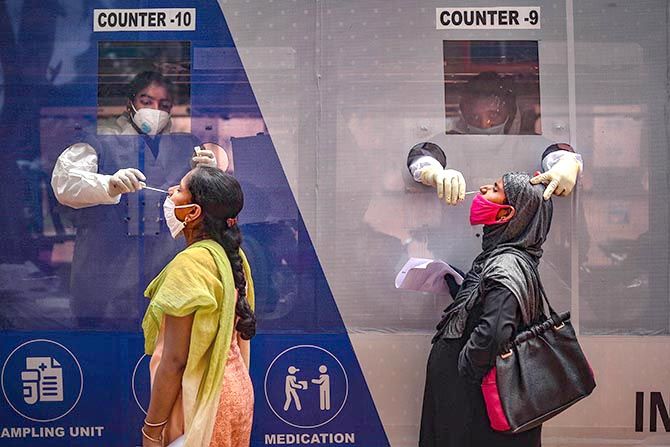
Airborne vs air droplets.
What's the difference?
Enough to compel 239 scientists from 32 countries, across the globe, to urgently write to the World Health Organisation, headquartered in Geneva, Switzerland, to revise their guidelines and declare COVID-19 an airborne disease.
And to you and me?
Enough to change our already impossibly complicated living conditions even further.
Now we need to wear a three-layered mask every single time we step out our front door, even say late at night at 2 am, when there is not a soul around, six feet away or 36 feet away, in case a load of COVID-19, borne by the breeze, lands on top of you.
But Dr Rajesh Parikh had already declared, as early as March 2020, shortly after the first few COVID-19 cases surfaced in India, in warning, that "differences between humans could cause the same infection's differential spread" leading to COVID-19 being also borne on a breeze or the draft from an air-conditioner, spreading it over much "larger distances" ie beyond the mandated social distancing of six feet.
The co-author of a handy manual titled The Coronavirus: What you Need to Know about the Global Pandemic, which released April 1, and will now be available as a paperback, online, from July 22, Dr Parikh and team explained, crucially, in their book that:
'Generally, COVID-19 patients produce large droplets, that fall to the ground and patients with infections like measles, produce small-droplet nuclei that can float in the air as an aerosol. Infections that spread via aerosol are called airborne infections, because they can stay suspended in the air for hours. Infections that spread via droplets, while not airborne, can be said to be borne by air. Some nuance can be lost in the oversimplified false dichotomy of airborne versus droplet transmission; they are not mutually exclusive'.
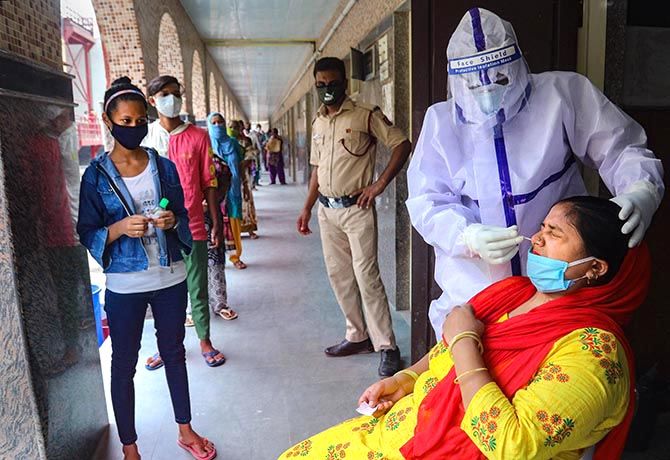
Dr Parikh, who is the director of medical research and honorary neuropsychiatrist at the Jaslok Hospital and Research Centre, south Mumbai, explained to Rediff.com's Vaihayasi Pande Daniel that the basis for this assertion was the significant work of an American scientist, William Firth Wells on the fate of respiratory droplets.
"What we wrote in the book then -- and actually we wrote this in the month of February, and it appeared in March -- we said this is all very nuanced and interestingly the paper we referred to was written in 1934," says Dr Parikh.
"W F Wells was then an instructor in the department of epidemiology at Harvard. And it's just incredible that at that time, he thought of this.
"Whoever thinks about a drop that is heading to the ground and about what can happen to that drop before it hits the ground? He plotted the mathematics of it -- what is called the Wells curve (or Wells evaporation falling curve of droplets) -- and he figured all this out and said that as the drop falls, it is affected, because of evaporation basically," explains Dr Parikh.
"Evaporation is affected by the temperature etc. You know, it is like when we dry clothes on a clothes line -- less humidity it dries faster, if there is wind it dries faster and if it is warm it dries faster, because the water gets sucked out.
"Based on that, Wells made this calculation -- it's a very complex thing -- but at the end of the day, it is very simple, because it says as it (a droplet) drops, because it is evaporating, it becomes lighter. Just before it hits the ground it is so light that it can fly in the air," Dr Parikh adds.
"We thought this was a very interesting observation (then) and that's why we've cited it in the book."
But these complex concepts -- relating to epidemiology, droplet curves, gravity, Stokes Law, and a Harvard 'eccentric genius' named Wells living in the 1930s -- do happen to have direct bearing on our COVID-19-commandeered daily life here in India.
Dr Parikh expounds further: "The question is between droplet-borne and airborne because that has practical implications and there is significant distinction.
"(From the point of view of) public interest is that if COVID-19 is about droplets, then all you need to do is to stay three to six feet away from a person and social distancing is the trick. If it is (transmitted by) droplets and if you stay six feet away nothing is going to happen -- you don't even need the mask.
"But if it is airborne then that's a strong case for wearing a mask at all times. If it is airborne -- and we don't know till what distance it can be airborne -- then the mask becomes a definite. Just social distance is not enough. You need a mask in addition to social distance."
Goggles too?
"Maybe. Maybe. But not necessarily" is Dr Parikh's measured reply.
So, we need a mask at all times? Not just in front/near of people? Even in a large open green park? But not at home?
"Yes, you are protected at home. But whenever you are outdoors you need it. Even if you are in a big park and you are taking a walk and somebody else is also taking a walk," because a gust of wind can bring it sailing to you.
And since Dr Parikh has felt that COVID-19 was airborne, he always wore a mask, even when he was on a solitary walk, since March, probably like the other scientists who are agitating for WHO to redefine this disease.
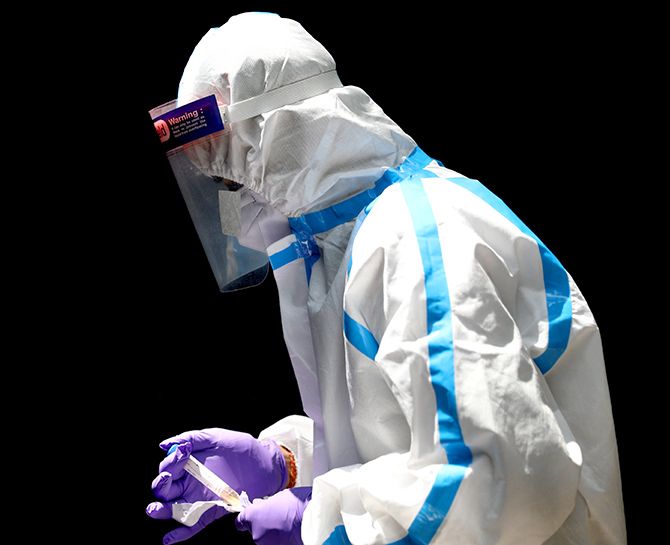
That COVID-19 could be also transmitted the aerosol route, through suspension in air, was already a given (as explained above). But as Dr Parikh says, aerosol transmission does not have greater impact and is largely confined to hospitals (which is why treating doctors always have PPEs and masks).
"Aerosol transmission may tell you don't go to restaurants. Or in restaurants don't blow the AC and all of that. But its implication is not very wide."
The acknowledgement of COVID-19 as airborne too, goes scarily beyond that.
COVID-19 is already a pandemic disease. It gaining the airborne tag also puts it into the category of other historical airborne pandemic diseases, like H1 N1 (swine flu) and Spanish flu.
And a disease known to be contagious from the start, has been discovered to have a higher level of contagion.
Dr Parikh adds, by way of clarification, and maybe comfort: "Contagious, but not that lethal. Spread is large, but the lethality is low."
Its tendency to be airborne and spread via the air too, explains to some extent now better why this disease has been moving so fast, spinning like a top, since its birth December last year?
"Absolutely."
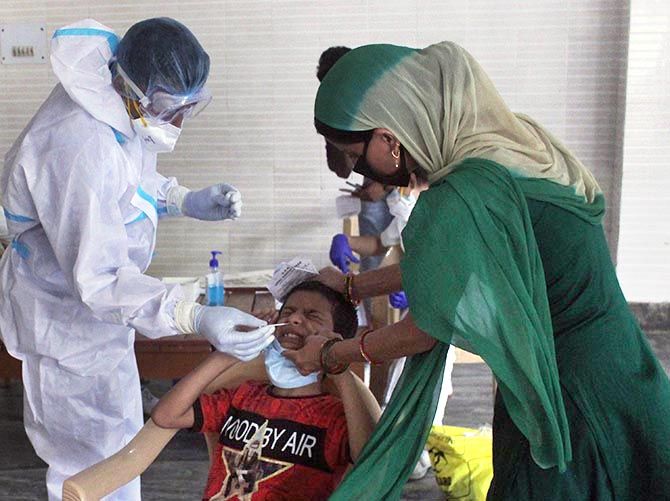
COVID-19 actually has taken many months to gain the 'respect' it required actually right from December. Till then its ferocity was disrespected. Dr Parikh recalls: "In March we had a conversation with (India Today anchor) Rajdeep Sardesai and there were 84 cases in India then.
"People were saying what's the big deal and we have more than that number dying of traffic accidents every day and nobody has even died yet. There were only 84 people ill in India and there were about 50 cases in the US around the same time.
"At that time, I talked to Rajdeep with some graphs and charts. I used the word abysmal twice in a sentence -- and I suddenly remembered my English teacher in school who would have freaked out if you used the same adjective twice -- I said the US is just as abysmal and India is abysmal... And Rajdeep said; 'You are scaring us, you are scaring us'."
"This is what we have asserted long back, actually in February, because that's when the book was written, though it appeared in March."
There is immediate practical importance in the WHO announcing that COVID-19 is airborne too.
"It's not just an academic discussion. If you are out, you will need the mask at all times. And I don't know why WHO is dragging its feet over this. I really don't understand. My feeling is that now in a day or two they will probably issue a statement that: 'Yes in rare circumstances this can happen which is true actually. It is true. It doesn't happen all the time."
"'As I told NDTV yesterday, just because it can happen, doesn't mean it does happen."
Feature Production: Aslam Hunani/Rediff.com








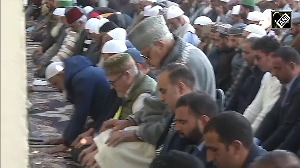
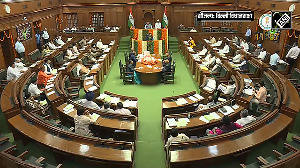
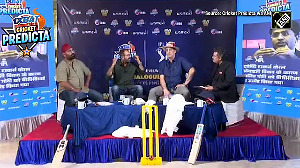
 © 2025
© 2025